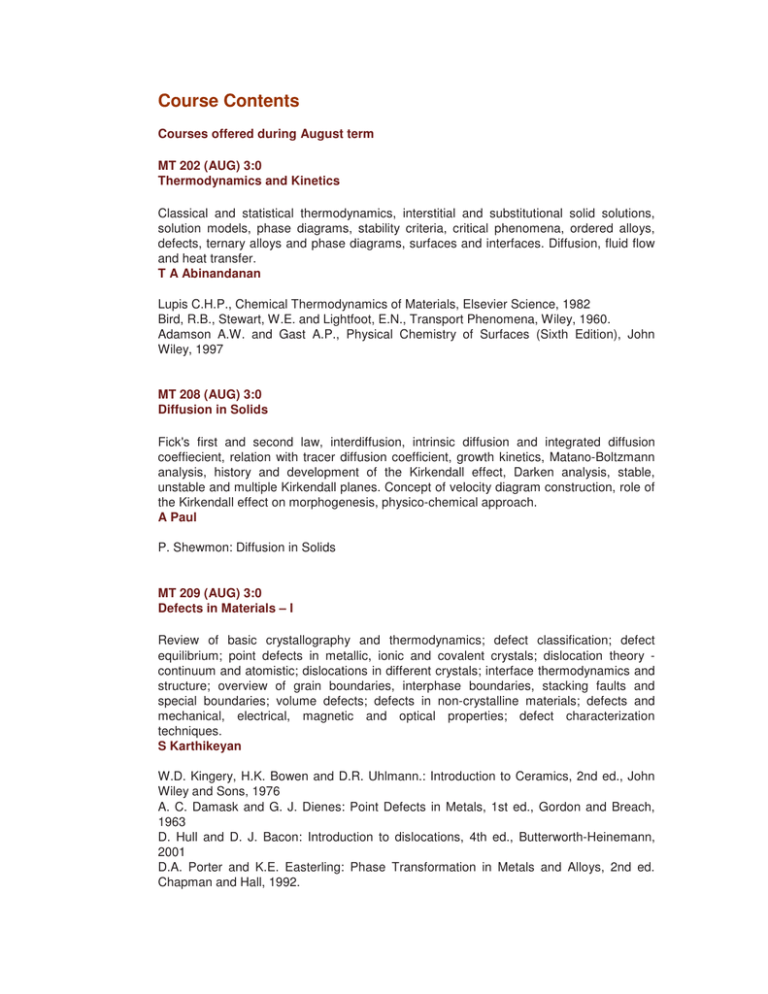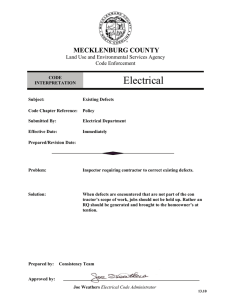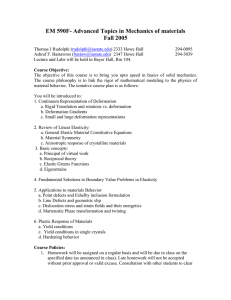Course Contents - Materials Engineering
advertisement

Course Contents Courses offered during August term MT 202 (AUG) 3:0 Thermodynamics and Kinetics Classical and statistical thermodynamics, interstitial and substitutional solid solutions, solution models, phase diagrams, stability criteria, critical phenomena, ordered alloys, defects, ternary alloys and phase diagrams, surfaces and interfaces. Diffusion, fluid flow and heat transfer. T A Abinandanan Lupis C.H.P., Chemical Thermodynamics of Materials, Elsevier Science, 1982 Bird, R.B., Stewart, W.E. and Lightfoot, E.N., Transport Phenomena, Wiley, 1960. Adamson A.W. and Gast A.P., Physical Chemistry of Surfaces (Sixth Edition), John Wiley, 1997 MT 208 (AUG) 3:0 Diffusion in Solids Fick's first and second law, interdiffusion, intrinsic diffusion and integrated diffusion coeffiecient, relation with tracer diffusion coefficient, growth kinetics, Matano-Boltzmann analysis, history and development of the Kirkendall effect, Darken analysis, stable, unstable and multiple Kirkendall planes. Concept of velocity diagram construction, role of the Kirkendall effect on morphogenesis, physico-chemical approach. A Paul P. Shewmon: Diffusion in Solids MT 209 (AUG) 3:0 Defects in Materials – I Review of basic crystallography and thermodynamics; defect classification; defect equilibrium; point defects in metallic, ionic and covalent crystals; dislocation theory continuum and atomistic; dislocations in different crystals; interface thermodynamics and structure; overview of grain boundaries, interphase boundaries, stacking faults and special boundaries; volume defects; defects in non-crystalline materials; defects and mechanical, electrical, magnetic and optical properties; defect characterization techniques. S Karthikeyan W.D. Kingery, H.K. Bowen and D.R. Uhlmann.: Introduction to Ceramics, 2nd ed., John Wiley and Sons, 1976 A. C. Damask and G. J. Dienes: Point Defects in Metals, 1st ed., Gordon and Breach, 1963 D. Hull and D. J. Bacon: Introduction to dislocations, 4th ed., Butterworth-Heinemann, 2001 D.A. Porter and K.E. Easterling: Phase Transformation in Metals and Alloys, 2nd ed. Chapman and Hall, 1992. MT 225 (AUG) 3:0 Deformation and Failure Mechanisms at Elevated Temperatures Phenomenology of creep, Microstructural considerations in metals, alloys, ceramics and composites, Creep mechanisms, Deformation mechanism maps, Superplasticity in metallic alloys, ceramics and nanophase materials, Commercial applications and considerations, Cavitation failure at elevated temperatures by the nucleation, growth and interlinkage of cavities. The course will also include some laboratory demonstrations of the phenomena discussed in class together with an appropriate analysis of the data. A H Chokshi Polreer, J.P., Creep of crystals, Cambridge University Press, Cambridge, 1984. Riedel, H., Fracture at high temperatures, Springer Verlag, Berlin, 1987. MT 233 (AUG) 3:0 Biomaterials This course will provide students with an overview of the field of biomaterials and the knowledge necessary to participate in biomaterials research or product development. Major classes of materials used in medical devices (polymers, metals, ceramics, composites, and natural materials): properties, chemistry, testing, and processing. Biocompatibility of biomaterials, protein and cell interactions with materials, immune and inflammatory responses to implanted materials, blood compatibility, and toxicity Applications: cardiovascular devices, drug delivery, and tissue engineering; regulatory issues. A M Raichur B. D. Ratner and A. S. Hoffman, Biomaterials Science: An introduction to materials in medicine, 2nd edition, Elsevier Academic Press. J. B. Park and J. D. Bronzino, Biomaterials: Principles and Applications, CRC Press. MT 241 (AUG) 3:0 Structure and Characterization of Materials Bonding in solids, packing in crystals and important metallic, ionic and covalent structures, lattices and point/space groups, diffraction methods, scanning probe microscopy, transmission electron microscopy, spectroscopic characterisation including x-ray, auger, electron, secondary ion and Rutherford backscattering, case studies. R Ranjan Barett, C.S. and Massalski, T.B., Structure of Metals, Pergamon Press, Oxford, 1980 Cullity, B.D., Elements of X-ray diffraction, Addison-Wesley, 1978 Williams, D.B. and Barry Carter, C., Transmission Electron Microscopy, Plenum Press, New York, 1996. West.A.R., Solid State Chemistry and Its Applications, Wiley, 1989 Current LiteratureM MT 245 (AUG) 3:0 Transport Processes in Process Metallurgy Basic and advanced idea of fluid flow, heat and mass transfer. Integral mass, momentum and energy balances. The equations of continuity and motion and its solutions. Concepts of laminar and turbulent flows. Concept of packed and fluidized bed. Transient and steady state heat and mass transfer. Natural and forced convection. Unit processes in process metallurgy. Application of the above principles in process metallurgy. Govind S. Gupta J. Szekely and N.J. Themelis, Rate Phenomena in Process Metallurgy, Wiley, New York, 1971 G.H. Geiger and D R Poirier: Transport Phenomena in Metallurgy, Addison-Wesley, 1980. D.R. Gaskell: Introduction to Transport Phenomena in Materials Processing, 1991. R.B. Bird, W.E. Stewart and E.N. Lightfoot: Transport Phenomena, John Wiley International Edition, 1960 F.M. White: Fluid Mechanics, McGraw Hill, 1994 Various research papers MT 250 (AUG) 3:0 Introduction to Materials Science and Engineering Compulsory For ME. students who do not have BE Metallurgy. Compulsory for research students without materials background. Bonding, types of materials, basics of crystal structures and crystallography; Thermodynamics, thermochemistry, unary systems; Methods of structural characterisation; Thermodynamics of solid solutions, phase diagrams, defects, diffusion; Solidification; Solid-solid phase Transformations; Mechanical behaviour: elasticity, plasticity, fracture; Electrochemistry and corrosion; Band structure, electrical, magnetic and optical materials; Classes of practical material systems: metallic alloys, ceramics, semiconductors, composites. Vikram Jayaram W.D.Callister: Materials Science & Engineering, Wiley (India) 2007 MT 252 (AUG) 3:0 Science of Materials Processing Fundamentals of materials processing: deformation processing, fundamentals and application of plasticity, yielding, operations specially conditioned by friction, flow instability, drawability, anisotropy, Thermally activated processes, dynamic recovery and recrystallization, modeling of materials processing, applications of deformation processing. Processing methods involving consolidation and sintering of powders.Structural size and its importance, bulk nanostructured materials by Severe Plastic Deformation (SPD), unique features of SPD and properties, nanostructured materials prepared by solid state processing, properties, benefits and application of nanocrystalline microstructures in structural materials. Satyam Suwas and R Ravi Deformation processing: W.A. Backofen, Addision Wesley.sProcessing of Metals and Alloys: Materials Science and Technology series, eds. R.W. Cahn and P. Haasan, Wiley VCH. Nanostructured Materials by Severe Plastic Deformation: eds. M. Zahetbuer and R.Z. Valiev, Spinger Verlag. MT 253 (AUG) 3:0 Mechanical Behaviour of Materials Theory of elasticity - theory of plasticity. Review of elementary dislocation theory deformation of single and polycrystals – temperature and strain rate effects in plastic flow - strain hardening - grain size strengthening, solid solution strengthening - order hardening, precipitation hardening, dispersion strengthening - strengthening by martensitic transformation, creep, fatigue and fracture. U Ramamurty Kelly, A and Nicholson R.B. (Eds.) Strengthening methods in crystals G.E. Dieter, Mechanical Metallurgy, McGraw-Hill, London (1988). MT 260/CH 237 (AUG) 3:0 Polymer Science and Engineering – I Fundamentals of polymer science. Polymer nomenclature and classification. Current theories for describing molecular weight, molecular weight distributions. Synthesis of monomers and polymers. Mechanisms of polymerization reactions. Introduction to polymer processing (thermoplastic and thermoset). Structure, property relationships of polymers: crystalline and amorphous states, the degree of crystallinity, cross-linking, and branching. Stereochemistry of polymers. Instrumental methods for the elucidation of polymer structure and properties; basic principles and unique problems encountered when techniques such as thermal (DSC, TGA, DMA, TMA, TOA), electrical (conductivity, dielectric), and spectroscopic (IR, Raman, NMR, ESCA, SIMS) analysis GPC, GC-MS, applied to polymeric materials. Thermodynamics and solution properties, solid state properties, viscoelsaticity, and rubber elasticity, Polymer Processing and rheology - Injection Molding, Extrusion, Compression Molding, Blow Molding, Casting and Spin Coat, Calendaring. P.C. Ramamurthy and M. Giridhar Principles of Polymerization, Odian Textbook of Polymer Science, F. W. Bilmeyer The Elements of Polymer Science and Engineering, A. Rudin Plastic Materials, J. A. Brydson Polymerization process modeling, N.A. Dotson Et al. MT 299 0:32 Dissertation Project MT 299A (AUG) 0:12 Third Term of Study Courses offered during January term: MT 299B (JAN) 0:20 Fourth Term of Study The M.E. Project is aimed at training the students to analyse independently any problem posed to them. The project may be a purely analytical piece of work, a completely experimental one or a combination of both. In a few cases, the project can also involve a sophisticated design work. The project report is expected to show clarity of thought and expression, critical appreciation of the existing literature and analytical and/or experimental or design skill. Faculty MT 201 (JAN) 3:0 Phase Transformations Overview of phase transformations, nucleation and growth theories, coarsening, precipitation, spinodal decomposition, eutectoid, massive, disorder-to-order, martensitic transformations; crystal interfaces and microstructure; topics in the theory of phase transformations: linear stability analysis, elastic stress effects, sharp interface and diffuse interface models of microstructural evolution. Chandan Srivastava Porter D. A and Easterling, E. E, Phase Transformations in Metal and Alloys, Van Nostrand, 1981. Jena, A. K and Chaturvedi, M, Phase Transformations in Materials, Prentice-Hall, 1993. Khachaturyan, A. G, Theory of Structural Transformation in Solids, John Wiley, 1983. Reed-Hill, R. E and Abbaschian R, Physical Metallurgy Principles, P.W.S-Kent, 1992. Prerequisites: Basic courses on crystallography, thermodynamics, phase diagrams and diffusion. MT 203 (JAN) 3:0 Materials Design and Selection After an overview of microstructures, processing and properties in engineering materials, the students will focus on procedures for materials selection and design. The students will explore materials selection charts, and the course will involve case studies, projects as well as software packages for materials design and selection over a wide range of conditions. D. Banerjee M.F. Ashby, Materials Selection in Mechanical Design, 3rd edition (2005). M.F. Ashby and D. Johnson, Materials and Design (2002). MT 213 (JAN) 3:0 Elements of Materials Physics Foundations of quantum theory; Schrodinger equation and its application to simple systems; electron theory of solids; basics of electrical, optical, magnetic and thermal properties of materials. Rajeev Ranjan , Satyam Suwas N. W. Ashcroft and N. D. Mermin: Solid State Physics R. E. Hummel: Electronic Properties of Materials MT 231 (JAN) 3:0 Interfacial Phenomena in Materials Processing Materials and surfaces, adsorption from solution, thermodynamics of adsorption - surface excess and surface free energy, Gibbs equation, adsorption isotherms, wetting, contact angle, Young's equation, monolayer and interfacial reactions, electrical phenomena at interfaces, electrochemistry of the double layer, electrokinetics, flocculation, coagulation and dispersion, polymers at interfaces, emulsions, applications in materials processing. S Subramanian Matrijivic E (Ed.), Surface and Colloid Science, Plenum, New York, 1982 Adamson A.W., Physical Chemistry of Surfaces, Wiley Interscience, New York, 1996 Laskowski J.S. and Rolston J (Ed.), Colloid Chemistry in Mineral Processing, Elsevier, New York, 1992. MT 243 (JAN) 0:2 Laboratory Experiments in Metallurgy Experiments in metallographic techniques, heat treatment, diffraction mineral beneficiation, chemical and process metallurgy, and mechanical metallurgy. Faculty MT 246 (JAN) 3:0 Light Metals, Alloys and Composites Overview of light metals; properties of aluminium, magnesium and titanium metals; strengthening by solid solution, precipitation, dispersion, grain refining and work hardening; casting, rolling, extrusion, forging, joining and finishing processes; properties and applications of light alloys; metal-matrix composites based on light metal matrix: principles, processing, properties and applications. Subodh Kumar Polmear I J: Light alloys: Metallurgy of the light metals, Arnold Press, 1995. Clyne T W and Withers P J: An introduction to metal-matrix composites, Cambridge University Press, 1993. MT 248 (JAN) 3:0 Modelling and Computational Methods in Metallurgy Basic principles of physical and mathematical modelling. Similarity criteria and dimensional analysis. Detailed study of the modelling of various metallurgical processes such as blast furnace, induction furnace, ladle steelmaking, rolling, carburizing and drying. Finite Difference method. Solution of differential equations using various numerical techniques. Convergence and stability criteria. Assignments will be based on developing computer code to solve the given problem. Prerequisite: Knowledge of transport phenomena Govind S. Gupta J. Szekely and N.J. Themelis, Rate Phenomena in Process Metallurgy, Wiley, New York, 1971 B. Carnahan, H.A. Luther and J.O. Wilkes: Applied Numerical Methods, John Wiley, NY, 1969. Various research papers MT 254 (JAN) 3:0 Mechanics of Contact, Thin Films and Interfaces Review of basic mechanical properties including linear elastic fracture mechanics; Thermodynamics of contact, surface energy and stress; Mechanics of contact using transform methods; Hertzian, JKR and DMT theories; Stresses in thin films and multilayers; Fracture in films and at interfaces; Methods of determining toughness and strength in small systems. V Jayaram and S K Biswas Thin Film Materials: L.B.Freund and S.Suresh, Cambridge Univ Press 2003 Contact, Adhesion and Rupture of Elastic Solids: D. Maugis, Springer 1999 Materials Science of Thin Films, Milton Ohring, Academic Press, 1992. MT 255 (JAN) 3:0 Solidification Processing Advantage of solidification route to manufacturing, the basics of solidification including fluid dynamics, solidification dynamics and the influence of mould in the process of casting. Origin of shrinkage, linear contraction and casting defects in the design and manufacturing of casting, continuous casting, semi-solid processing including pressure casting, stir casting and thixo casting. Welding as a special form of manufacturing process involving solidification. Modern techniques of welding, the classification of different weld zones, their origin and the influence on properties and weld design. Physical and computer modeling of solidification processes and development of expert systems. New developments and their possible impact on manufacturing technology in the future with particular reference to the processes adaptable to the flexible manufacturing system. K Chattopadhyay J. Campbell, Casting, Butterworth - Haneman, London, 1993 M.C. Flemings, Solidification Processing , McGraw Hills, 1974.MT MT 261 (JAN) 3:0 MT 261 Polymer science and engineering II Fundamentals of polymers. Electroactive polymers. Device physics: Crystal structure, Energy band diagram, Charge carriers, Heterojunctions, Diode characteristics. Device fabrication techniques like Solution, Laser ablation, Evaporation. Devices like Organic photovoltaic device, Organic Light emitting device, Polymeric sensors. Stability of organic devices. P.C. Ramamurty Handbook of Conducting Polymers Third Edition CONJUGATED POLYMERS THEORY, SYNTHESIS, PROPERTIES, AND CHARACTERIZATION Edited by Terje A. Skotheim and John R. Reynolds, CRC Press. Handbook of Conducting Polymers Third Edition CONJUGATED POLYMERS PROCESSING AND APPLICATIONS Edited by Terje A. Skotheim and John R. Reynolds, CRC Press. Organic Photovoltaics Mechanisms, Materials, and Devices by Sam-Shajing Sun Niyazi Serdar Sariciftci. CRC Press. Semiconductor Physics and Devices Basic Principles Donald A. Neamen, McGraw Hill publications. MT 304 (JAN) 2:1 Defects in Materials II Review of defects in materials; point defects and diffusion; electrical and optical effects of point defects, advanced dislocation theory; dislocation kinetics; interface structure and energetics, grain and special boundaries, interface kinetics: migration and sliding; interfaces in phase transformation and plastic deformation; electronic properties of interfaces; volume defects; defect interactions: point defect-dislocation interaction, dislocation-interface interactions, segregation, high diffusivity paths, etc.; atomistic simulation of defects. S Karthikeyan J.P. Hirth and J.L. Lothe: Theory of Dislocations, 2nd ed., Krieger, 1982 A. P. Sutton and R. W. Balluffi: Interfaces in Crystalline Materials, 1st ed., Oxford Univ. Press, 1995 P. Shewmon: Diffusion in Solids, 2nd ed., TMS, 1989 R.W. Balluffi, S.M. Allen, W.C. Carter: Kinetics of Materials, 1st ed. Wiley-Interscience, 2005 Prerequisites: MT209: Defects in Materials-I, MT202-Thermodynamics and kinetics, MT241: Structure and characterization of materials MT 306 (JAN) 2:1 Topics in Physical Metallurgy Thermodynamics and kinetics of interface migration; Theory and computational modelling of microstructural evolution during grain growth, sintering, spinodal decomposition, disorder-order transformation. T. A. Abinandanan A.G. Khachaturyan: Theory of Structural Transformations in Solids, John Wiley, 1983 Current literature


